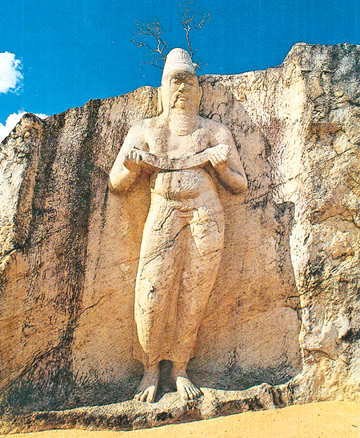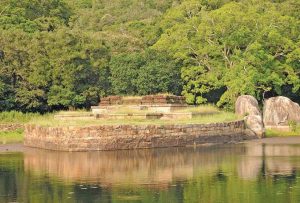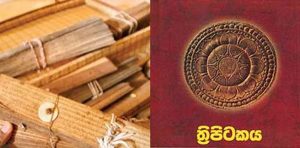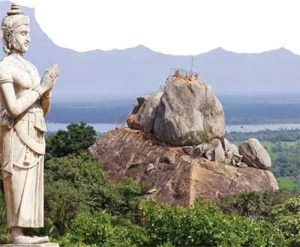
After the Kingdom of Anuradhapura, Sri Lanka destroyed the Chola power and made the Polonnaruwa Kingdom a permanent Buddhist state, with its capital as Pulathsi Pura or Polonnaruwa. The next ruler of this country after King Vijayabahu the Great was Parakramabahu the Great.
During the reign of King Mahaparakramabahu (1153 – 1186 AD) a building named Pothgul Vehera was built. It is thought that the monastery may have been named after it, as there may have been a booklet or library. Our ancient sculptors have built a very fine stone structure in the nearby rock. It is famous as the Statue near Pothgul Vehera. The name is even more pronounced as the statue of Par පරාkramabහුhu, which made our country a self-sufficient country and an independent, powerful nation that did not belong to any state.
The nature of the statue
The statue was raised in the same stone as the statue. Its height is 11 feet 6 inches. There is a popular opinion that this is the statue of King Mahaprakramabahu. The name Pollinaruwa can be used also. The statue is said to be a statue of the Pulasthi scholar. Some believe that this is the image of the Rishish. Others have suggested that the statue depicts Agastya or Kapila Rishi. The scholar Barrows mentions the statue of King Parakramabahu holding a law book in his hand. Prof. Senarath Paranavithana offered his opinion first, claiming that the statue was a reflection of an ascetic or sage, but later changed his view to that of a statue of King Parakramabahu. The inscription on the back of the statue’s head is called Pula-ta. If this interpretation is acceptable, it reflects the Pulasthi sati, and no further dialogue is necessary. However, there are still possibilities of studying the statue to inspire new ideas.
Prof. Anuradha Seneviratne, Medieval Capital of Polonnaruwa, p. 108 Published by the Department of Archeology. – 1998).
According to HCP Bell, the first archaeological commissioner of the Department of Archeology, the statue is not a statue of a king or a Buddhist monk, but clearly a statue of a famous teacher. According to him, this is a statue depicting Kapila Sisi. Dr. Ananda Coomaraswamy supports both these views and says that it is either a king or a scholar. Some think that the statue is in the palm of the hand, and Professor Senarath Paranavitana thought it was the yoke of the state symbol.
Features of the Statue
The statue is of mild hair with mottled hair, long bearded abdomen, subtropical, to some extent age and wisdom. However, the abdomen is not visible. There is no statue of this kind anywhere in our country. However, there is only a small statue on the back wall of the Shiva Temple which is No. 1 in Polonnaruwa.
It is customary for scholars to discuss the statue of Polonnaruwa as a statue of King Mahaprakramabahu. It was King Vijayabahu the Great who preceded King Parakramabahu the Great to overthrow all the forces of the Southern Bharatha who had a huge foreign Chola power and navy during that period. Neelakanta Shastri, a professor of history in the South, said that it was the end of Sinhala Buddhists if he was not a Vijayabahu. This was in line with the view of Professor Senarath Paranavitana.
(King Mahavijayabahu – Sirisaman Wijetunga Sangamonde 11th Dayasamsa Jayakody & Company)
No such statue of such a king has ever been made or made in history. There is no doubt that this building attached to the statue of Mahaprakramabahu is a Buddhist monastery complex. In its present name, it is a monastery, or a bookgirl, which is supposed to be of a Brahmin scholar who holds a leaflet in his hands, symbolizing wisdom and wisdom. The statue is simple and out of date. The jatamakutu is missing but tied together like a hair clot. The mustache and the long beard show a definite Indian style and show the maturity and wisdom of the scholar. If the great scholar Mahaparakramabahu invoked the knowledge of the Veda Vedanga and the educated Brahmin priests during his reign to enable him to expand his education here, this statue is the brahma statue of King Parakramabahu, who was revered by Parakramabahu the king. More motivating. If we accept this statue as a portrait of a Brahmin who holds a leaflet in his hand, its identity can be resolved without undue debate. There is some connection between this statue and the nearby temple. The ruins of a building to the east, near the statue, could be seen.
(Polonnaruwa – Prof. Anuradha Seneviratne p.112 (1998)






